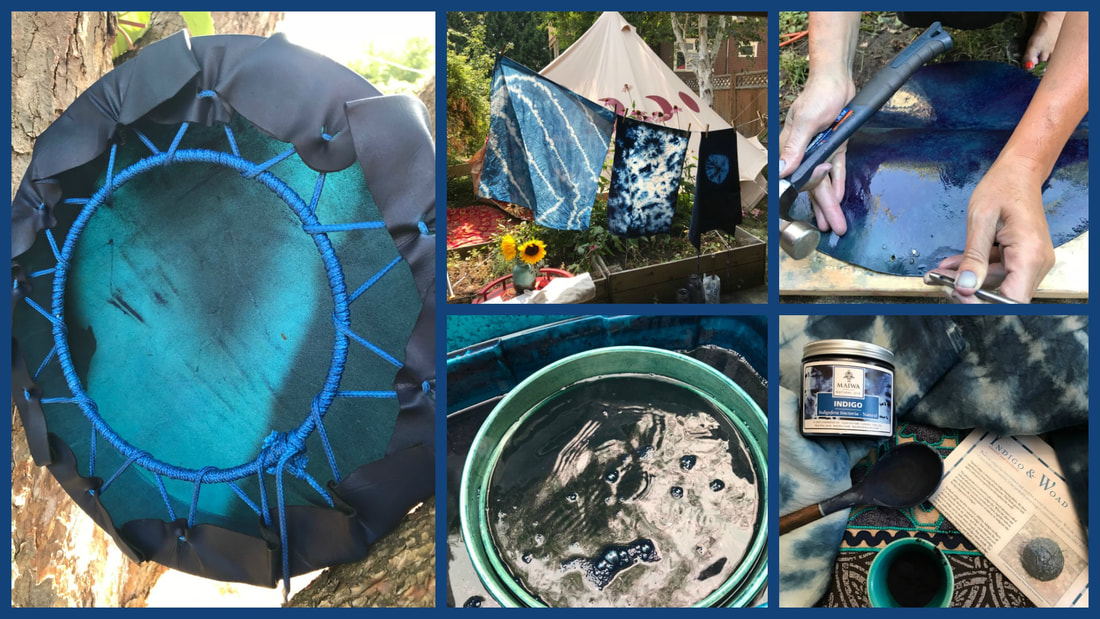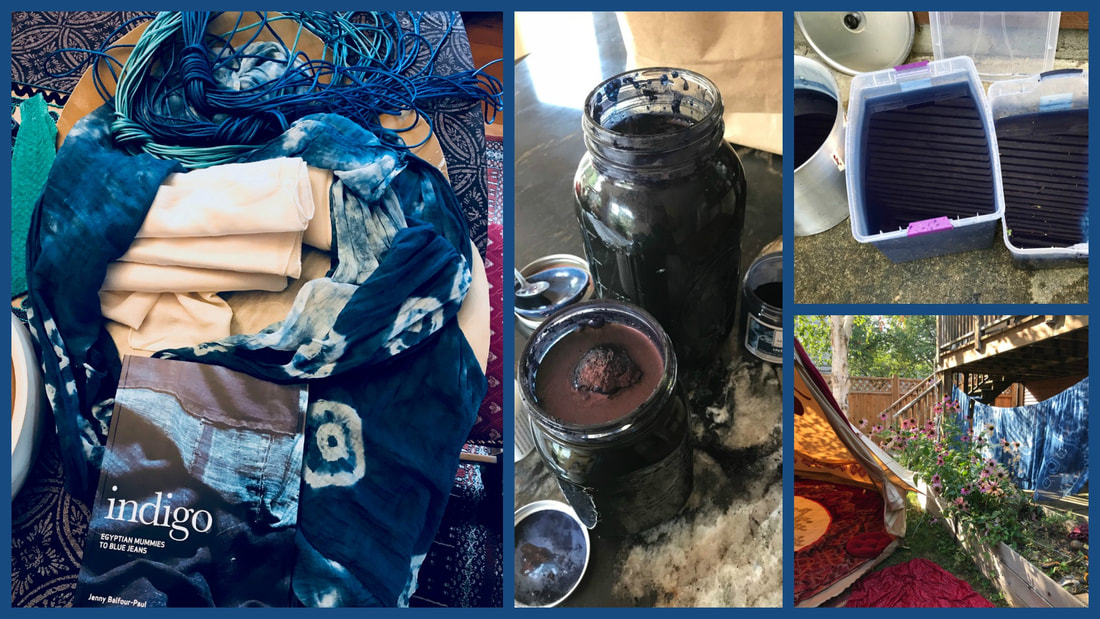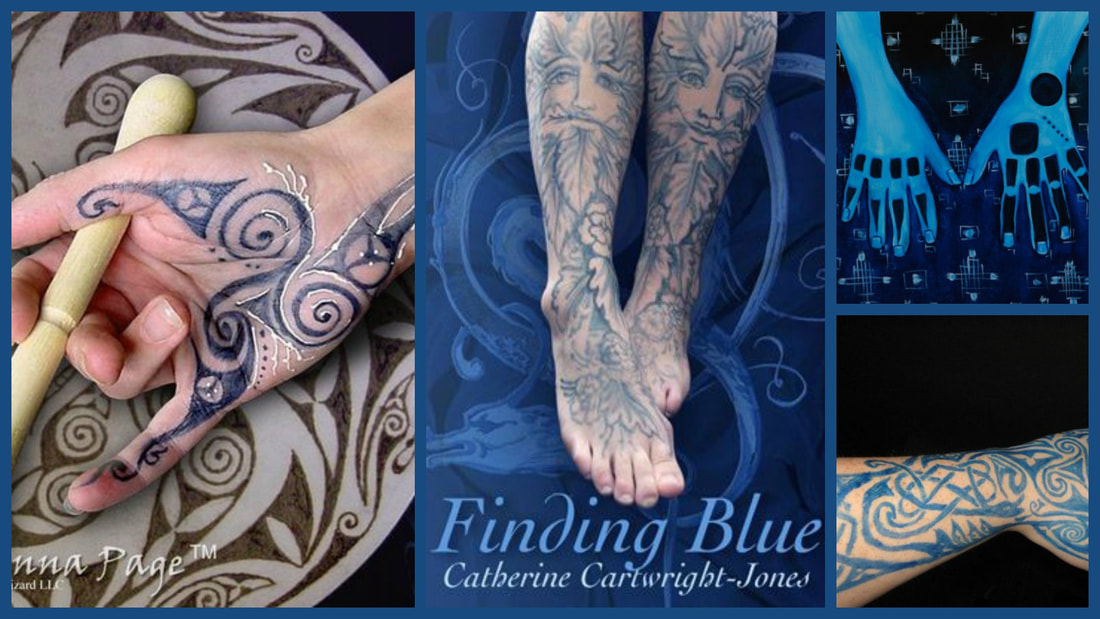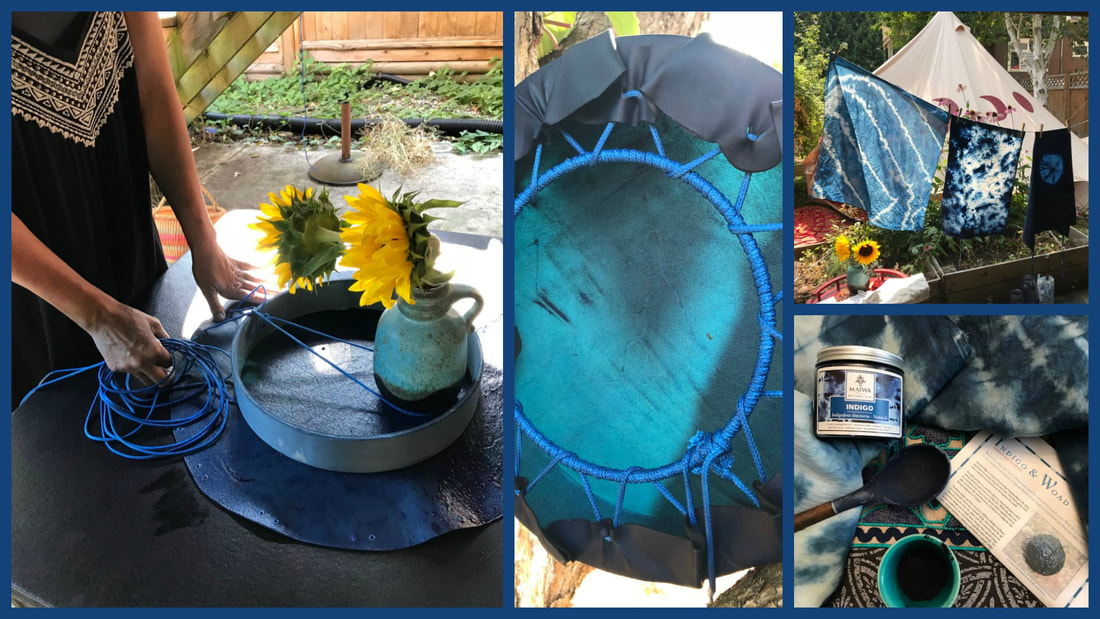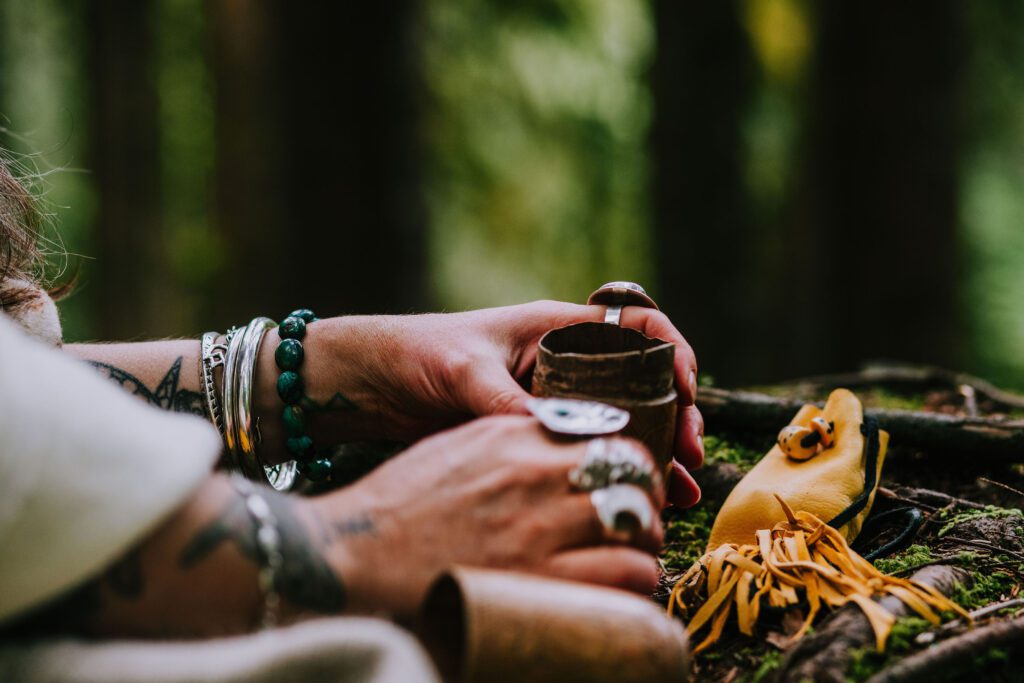What is the difference between Indigo and Woad?
What is the same about these two is that the compounds in the leaves, when extracted, both produce blue pigment called Indigo.
From what I understand Woad is easily grown in Europe, thus the history of use there, and Indigo although referred to as the colour produced, is also a plant grown in more tropical climates, and the Indigo that is gathered from these plants is deeper then what one is able to obtain from Woad.
I imagine that a more lush tropical climate must be the reason for the compounds that create the blue colour of Indigo to be deeper then the Woad grown in Europe, but that is just a guess…
The introduction of Indigo to Europe came by way of Asia is the middle ages they say as early as 1140, and initially it was was sold in hard lumps and used as an ingredient in paint for artists.
It was not until the 1500 that it started to be imported and used for dye which made woad dyers quite uneasy, however it seems that the use of woad for dye was slowly departed from as the darker colours of the more tropical Indigo were discovered.
It is said that where woad is a slow blue Indigo is fast, but the truth of the matter is this–both require deep alchemy in order to achieve any kind of lasting colour!
“In Europe and in the British Isles, when woad was the only affordable blue, processing began with the crushing and composting of leaves. The mixture was shaped into balls dried for storage and transport. Inside the balls, a tiny secret was at work: a bacterium, Clostridium isatidis, thriving in the interiors, using up the oxygen, beginning a transformation by fermentation that led to blue pigment.
Woad, the plant whose deep blue pigment was used as a warpaint by the ancient Britons to frighten their enemies, is to be farmed commercially in Britain for the first time in 500 years.
Large-scale production of woad, which was most famously used by the warrior queen Boudicca, finally died out in the 16th century when cheaper dyes imported from India made it uneconomic.” Source
Woad has long been connected with the Icenci tribe and it’s famous leader Boudica who was said to have painted her face with paint before going into battle, and we now know that woad is also antiseptic and may also have been used to heal battle wounds! The thought with painting the face Blue was to frighten the enemy by having a fierce face done is a colour that would have been hard to achieve anywhere else. of course back then Urine would have been one of the magical ingredients needed to turn the green dye blue….
From what I can understand the myth and magic of this alchemical dye has literally been found most of the world over, and ancient history shows that not only was it used for dying fabric, but also it was used for tattooing in Japan, for burial shrouds in Egypt, in trade as currency from Africa to to Central America and on and on… and it certainly not just contained to my personal European ancestors–so if this colour has captivated you as much as me chances are your ancestors used and wore it too!
Indigo was used to ward off evil spirits and the secrets of it’s facinating alchemical process were guarded fiercely by those who would eventually pass them down through the family line, or sometimes passed through secret ritual and ceremony from one dyer to another in the line.
Because I am always interested in finding my own ancestral links and understandings I was fascinated by the use of Woad as a colour of warriors and in domestic use for dying wool and clothing as well as the idea of dying drums this colour for use in ceremony.
It is said that the ancient Celtic Picts used woad for drawing on their bodies before battle and I found a fascinating book “Finding Blue” which goes into this history as well as giving a recipe and images for doing just that {see images below} but I have also read that this is not dependably accurate and so the search continued until my understanding-although not exhausted, has come full circle in that I now see that this line of my ancestors were an extremely adaptable and creative peoples {sounds familiar} and somewhere in it all lays a speckle of truth-and I am sure that speckle was Blue!
To this end I decided to ask my own helping ancestors directly and see what they had to say for it all, as they were also a pragmatic people who did not tolerate fools easily…
In the end I felt my connections deepened and I was shown a drum dark as ravens wings and used for a very specific purpose in death and grief work, which I have yet to make, as it will take more time, ceremony, and thought on my part before I even begin, as these kinds of things are not to be rushed in any way.
However, before all of this I enjoyed a few full days of dying and made a few sacred drums for sale which I have finally listed up in the Drum Shop.
I had dreams of dying several drums the deep dark colour of Ravens wings and since spirit seemed to be pleased with my plans I went ahead and prepared both hide and fabric for the big day!
The day found my teenaged daughter joining us which was also a delight and many friends dropped by for a few hours at a time enjoying company and being creative together, which I believe sits at the heart of woman’s work, priestessing and supporting one another in the most of organic and natural ways–gathering at the Red Tent to work with our hands.
And so it was that my love for Red was combined with Blue, with women and the ancestors– there is not much more that this spirit worker would want for…..
Indigo-Egyption mummies to blue Jeans By:Jenny Balfour-Paul
History of Woad
The Secret History of Okinawan Tattoos
Finding Blue By Catherine Cartwright Jones
Indigo–In search of the colour that seduced the world By Catherine McKinley
Dyeing with Indigo By: Elizabeth McTear
I did it!
Some of you may remember my sharing a video of a looooong piece of weaving I took off the loom about a month ago musing on what I might make with it…
Well after weeks of travel I arrived home ready to take the risk and cut into my precious weavings and sew them.
-
The thing is I had no pattern and my sewing machine broke before I even had a chance to use it once!
But since I have taken some fabulous classes with my teacher India Flint @prophet_of_bloom where she shares her fearless use of scissors and patternless hand made sewing I decided to go for it and I am thrilled with the result.
-
Having said that it helps that I am not even remotely type A, nor do I care about seams showing etc…
-
It’s wickedly “handmade” and perfect for the essence I carried all through its creation which was all about this second half of my life, peri-menopause and initiation..
-
These things have been messy, creative, hard, and I have learned so much!
Kinda like making oneself a coat from woven fabric without a pattern or sewing machine ha!
-
Anyways I am back home now and excited to dive into some summer weavings and drum making, and pairing them together so that you can take them out on your outdoor adventures, stay warm at night and connect to the rhythm of the land..
-
Stay tuned!
-
Big love
Nikiah
-
#weavings #saori #sacredweaving
-
I am thrilled to have some of my weaving creations over in Salt Spring Island at @folklore_studio_co .
-
@tarynstrong and her partner @sydwoodward_ have created a fabulous store supporting local artists as well as selling their own fabulous jewelry creations.
-
I look forward to visiting them later this summer and seeing my weavings in the shop.
-
Have a beautiful day everyone.
-#weaving #sacredweavings #folklore #supportart
This image was taken by @_infinitebody_ a few years ago now and is such a beautiful reflection of the many times we have worked together to create a story within an image within a myth..
-
Images have always captured my imagination and I have long loved photography, so to be able to manifest what is in my mind and heart together in sacred collaboration has been a dream.
-
If you have been in my website or here on insta with me for awhile you would have seen many of these images taken by Jennie, as we navigated shoots by waterfalls, the ocean, the forest, mountains, rivers and meadows..
All in search of beauty, mythic storytelling, ancestral connection and what it means to create art from our lives,guts and souls..
-
For me the fact that I am in the image is not even remotely as important as the feeling or story I hope that you dear ones will experience once you lay eyes on it..
In fact I often wish I had a model instead of myself because it’s really about creating an image that evokes a feeling and a story..
This is the gift that Jennie has..
-
Anyways Jennie @_infinitebody_ has some beautiful offerings happening right now if you are feeling called.. go check out her work.
♥️
-
In the meantime I am back in beautiful B.C and soaking up the sun home and cherry blossom’s as we visit our daughter and prepare our home here for sale this coming summer.
-
What does this image say to you?
What story does it tell or make you think of? I would love to hear your thoughts…
-
I will post a bunch more tomorrow, and include some that I have never shared here before..
Perhaps we can create a story together..
-
#sacredphotos #stories #unseeen #reddrum
Every now and then I sit with my website and read through it, because written words tend to become static once written, and I as a person am not.
-
I continue to change, my work changes, and how I would even describe my own work changes too..
-
So today I sat with my bio page and made some changes, sharing a little more about my own evolution, who I am and why I do what I do…
-
I am not completely done with it yet but it feels better to me, kind of like when we outgrow our old skin, shedding needs to happen..
-
Over the years my sites have constantly been in a flux of change and evolution, expanding and being fluid with growth as I do the same..
-
Right now I am in another time of change, actually it’s been a few years of this, but slowly, ever so slowly my work is expanding, and getting itself ready for new iterations…
-
So although all I worked on today was my bio page, I am feeling that there is much more to be added in the next few months..
-
What does this kind of change feel for you? And how does it get reflected in your work? I would love to hear how others share change..
-
Big love
Nikiah
-
#change #evolution #website #animism
It’s a SCAVENGER HUNT! I’m part of the Ways We Witch summit this weekend, and it’s time for some fun! Search the tag #wayswewitch for four clues and enter them at www.wayswewitch.com/fun to play (I hear that everyone wins!). The summit is all about the different ways we practice connection in our lives and one of my favorites is brewing up herbal tinctures and syrups for my family to enjoy.
-
Your scavenger hunt clue is MAGICK.
-
#wayswewitch
Sometimes I just like to wander around my studio and see what inspires me.
-
Some days it’s spinning or weaving, but sometimes I pull out alll my paints and go crazy for a few days, then leave it for what can be months before I get inspired again.
In fact I have a painting I started at the begging of Covid still waiting for completion haha.
-
Sometimes I pull out all my beads and make several sacred pieces all at once!
-
Last solstice I bought a ton of fabric and sewed like crazy making all sorts of different sized bags to replace the old fabric we had been using for years to wrap gifts..
-
Spring inspires to forage especially for wild violets to make syrup with.💜
And the end of summer I forage wild roses for my tinctures.🩷
It really just depends on the muse at the moment…
-
How about you? What stokes your creative fires?
-
#creativity #beltane #studio #art #weaving #sacredmuse
The Ways We Witch Summit begins May 5th and is three full days of juicy, deep, Magickal offerings from a variety of incredible contributors!
Our box office is now open and at a very special price. Check it out by visiting the link in bio.
-
#wayswewitch #redmoonmysteryschool #nikiahseeds #witchesofinstagram #witches
I am excited to be a part of this wonderful lineup of folks offering this summit. I have recorded a talk in animism that I hope folks enjoy.
-
The Ways We Witch Summit box office is now live! This is an incredible Summit happening virtually May 5th-7th with both live and pre-recorded talks. You'll get lifetime access when you purchase your ticket so you can come back to a session at any time! With over 25 contributors and over 33 offerings between them, you'll be sure to learn something new whether you're a seasoned Pagan or baby Witch new on your path!
Currently, there is a fast track ticket option of $97 USD (more than 60% savings!) until Friday so it's the best time to save! This means it's less than $3 per session - that's wild! Afterwards, ticket prices will go up so hop on board now to take advantage of this incredible discount!
-
Link in my bio…
-
#thewayswewitch #witchlife #animism
Packing up these delicious welcome packages today as I welcome a new group into the Sacred Path Apprenticeship.
-
The phenology wheel books you see here were a labour of love I created a few years ago now as a part of how we deepen our connection to the land, and the unseen.
-
It’s just one part of many that make up the 13 month initiatory journey that is the sacred path…
-
The doors will open again in the fall and from that point on I will only be opening up the doors once a year…
-
This will allow folks time to sit with if it’s a good fit and for me to work on some other things I have been planning and dreaming of offering.
-
Have a beautiful day everyone!
Nikiah
-
#ancestral #phenology #animism #shamanichealing #spiritworker #priestesspath
In a world that often overlooks the importance of initiation, many of us find ourselves feeling lost and disconnected from our true selves. But what if we could remember and honor our own initiatory processes?
-
As an animist teacher following the pathways of my ancestors, I invite you to join me on The Sacred Path. Through deep connection with the forest, your guide, your ancestors, and yourself, we will journey to reawaken the mythic soul within. 🌳🔥🌕
-
Consider for a moment the impact on your life if you had experienced your initiations as important rites of passage. How would it have changed or shifted your view of the world, yourself, your gifts, and your purpose? And know this, my friends, it is never too late to claim those initiations for yourself.🌟✨
-
The doors are closing soon so DM me to learn more about the Sacred Path Apprenticeship and how you can join. 🙏💚
-
#animism #spiritualitytraining #ceremony #ancestralwisdom #connection #spiritworker
This is the longest piece I have woven on my saori loom to date and it’s taken me a few months, but I have loved the process, especially not knowing what the final piece would look like and just trusting the process…
-
Next up-sewing it! This is the scary part because it will require cutting etc…
-
Also happy New Moon folks!! 🌀⭕️🌀
-
#saori #weavingloom #newmoon
A little introduction:
My name is Nikiah {pronounced Nik-Eye-Ah}, and I am a fourth-generation settler currently living on the unceded lands of the Lenape, Munsee, and Mohican First Peoples.
-
My ancestors came to Canada via Romania, Scotland, Ireland, and England. The exploration of my ancestry has, and continues to, deeply influence my work and own healing.🌲🌳
-
For over two decades, I have been creating ceremonies for the birth, death, and re-birth cycles that we as humans experience. I am a traditional animist Spirit worker/Healer, initiated into northern European animist tradition and guided by many teachers over the years.🐻
-
I have raised two children with my partner of 25 years and am now focusing more on my community, both global and immediate.
-
The Red Moon Mystery School is where we explore the deep wisdom of our ancestors, the natural world, and our place within it. 🌎
-
Whether you are looking to deepen your spiritual practice, connect with your ancestors, or explore the unseen realms, I offer mentorship and leadership programs, sacred weavings and altar items, and initiation paths to support you on your journey.
-
Join me as we reconnect with the sacredness of life, and honour the beauty and diversity of a spirit-led life.
-
The doors are open now!
Pop me a message if you would like a direct li k. ❤️
-
#Animism #Spirituality #Ceremonialist #Healing #AncestralWisdom #Community #Connection #spiritworker
The idea that we all have a wellspring of wisdom within us is a core belief that I carry in my own life and the work I put out into the world. I believe that by connecting with our ancestors, practicing animism, and working in the liminal spaces between, we can tap into a deep source of knowledge and understanding. Whether it’s through meditation, ritual, or simply spending time in nature, there are so many ways to access this inner wisdom and bring it into our daily lives.
-
What happens when we take a moment to honour our ancestors, connect with the natural world around us, and embrace the magic of the liminal spaces? For me, there is ease and magic and a sense of feeling held.
-
I’m curious to know what happens for you?
-
And if you are new to exploring what it means to be in connection with your ancestors, with the land and the spaces in between, is this something that piques your interest and curiosity? 🌿✨🌙
-
#AncestralConnection #Animism #LiminalSpaces #WisdomWithin
#Spirituality #Meditationn #Ritual #Nature #Magic #Inspiration
The doors to the Sacred Path Apprenticeship are open now, and close on April 25th.
-
The Sacred Path Apprenticeship is an initiatory certification program designed for spiritual seekers, empathic coaches, visionaries, creative leaders and anyone longing to reclaim their own spiritual path by discovering a way of being that is unique to their own life and inner self.
-
Learning how to journey is a big part of the Sacred Path apprenticeship, and over the course of 13 months together you will be invited to journey into a sacred grove of trees to meet the spirit of each tree in the grove and receive wisdom as it pertains to your life.
-
Before this though, you will be invited to discover your own unique way of journeying, how to do it safely and you will meet an animal ally to accompany you on your journeys.
-
This is what makes the sacred path different, perhaps form other courses out there, as journeying to communicate with a helping and loving ancestor, as well as a sacred animal ally over time become fundamental to our spiritual practices and experience with the seen and unseen world around us.
-
Over the next few days I will be sharing more about what you will find inside the doors to the sacred Path, but if at any time you have any questions I am always happy to answer them, just pop me a DM and we can go from there.
-
#sacredpath #ancestralhealing #walkyourownpath #intuitiondevelopment #redmoonmysteryschool
Images by @_infinitebody_
The doors to the Sacred Path are open. We begin May1st.
-
Will you enter?
-
The Sacred Path Apprenticeship is an initiatory certification program designed for spiritual seekers, empathic coaches, visionaries, creative leaders and anyone longing to reclaim their own spiritual path by discovering a way of being that is unique to their own life and inner self.
-
On this path you are invited to journey into the unseen realms by first finding your own way of accessing and then trusting your own sacred gifts.
In this way you will walk the ancient pathways of the archetypal goddesses, and your ancestors.
-
There are nine initiations we work within:
~ Journeying into the unseen realms
~ Archetypal and shadow work
~ Journeying into the forest & developing a sacred relationship to trees
~ Meeting the goddess cross-culturally
~ Creating a sacred archetypal bundle
~ Beginning an animist practice by working with the land spirits
~ Meeting a healing ancestor and beginning to create an ancestral spiritual practise
~ Working with the seasons and cycles of our bodies and the world around us.
-
#spiritcommunication #animist #mysteryschool #everythingisalive #everythingisenergy #iching #journeywork #archetypes #dreaminterpretation #precognition #kitchenwitch #ancestorveneration #animism
The Doors to the Sacred Path Apprenticeship open today!
AND
I am going to be giving a talk at 1:00 EST to talk about it all.
-
If you have been feeling called but would like to know a little more, or perhaps reading through everything on my site feels a little overwhelming, I will be sharing a ton of information about it all, and showing the wonderful contents of the welcome package that every student gets too :]
-
If you can't make it though, not to worry, as I will also make sure to post the video on my wall here so you can watch anytime.
-
If you have any questions you would like me to go over leave me a message here or pop me a DM and I will make sure to cover it.
-
See you later today!
-
Nikiah
-
#sacredpath #mysteryschool #animism #ancestralhealing #spellwork #witches #priestesspath
I am so excited to be opening up the doors once again for The Sacred Path Apprenticeship.
-
The Sacred Path Apprenticeship is an initiatory certification program designed for spiritual seekers, empathic coaches, visionaries, creative leaders and anyone longing to reclaim their own spiritual path by discovering a way of being that is unique to their own life and inner self.
-
This course is also for folks wanting to sink into an intuitive way of deepening their own spirituality by following their own pace without the need for attending circles or zoom calls.
-
Doors open up for folks on the waitlist on April 10th, so if you are curious or perhaps interested pop me a message below or send me a DM and I will send you a direct link to learn more.
-
Lots of love
Nikiah
-
#sacredpath #priestesspath #sacredcalling #intuitive #spiritcommunication #spiritjourney #shamanic #ancestors #mysteryschool
Looking back in my recent trip to Morocco today and seeing alll of the blue door photos I took I thought it might be fun to share a little reel of them.
-
Morocco was the most magical place I have ever visited and we are already plotting out trip back.
-
It was also so fun to bring back some of the magical things that were in my most recent giveaway, and I am happy to@say that I have a few more tucked up my sleeve for the next one.
-
For folks new to my account I love to give things away as much as I love creating and sharing my work so I am often found doing them every few months or so.
-
The other thing that I loved learning about was the textiles and about the Majorellle blue that is found everywhere but most in doors.
It is used as an evil eye for protection of sorts and I even brought some back with me in the form of Indigo which I will be sharing more about soon.
-
In the meantime enjoy this collection of beauty…
-
Big love
Nikiah -
#morocco #doors #majorelleblue #majorellegarden #sacredportals
The one thing we often do not talk about is all of the little things that go into the creation of intentional pieces.
-
Like with these elemental shawls you see me folding here.
-
There are many small steps that need to happen before they are ready to find their new homes…
-
Things like tying the tassels just so at the bottom of the weaving after its finished, wet washing the pieces so the fibers bind together and make the fabric stronger.
-
Then, there is the time spent describing all of the beautiful yarns that I have chosen for each piece with intention, as I like to create a palette of colors before I begin each piece, kind of like painting…
-
Because each piece is created with an intention or a theme i like to really work with that aspect as I work on the piece, such as when I was weaving the fire elemental shawl you see here I had lots of candle lit around me, and my water fountain was sending out the most wonderful watery trickling sounds as I wove the water shawl, and well you get the idea….
-
Then there are photos to be taken so the uniqueness of each creation can be seen and finally they are all folded up ready for their new homes to find them….
-
These elemental pieces were such a joy to make and are now ready to find their new homes….
-
#intentionalweaving #intentions #sacredweaving #ancestralweaving #fire #earthgallery #air #water


